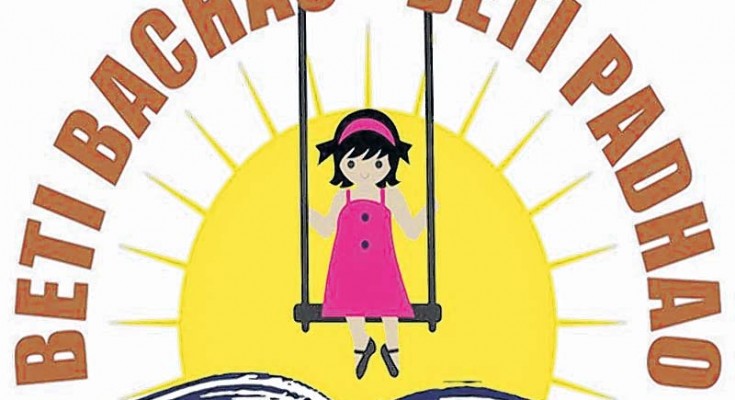 IMPHAL, Jun 17 : In the year 2015 under the flagship programme of the Government of India, Prime Minister Narendra Modi launched the Beti Bachao Beti Padhao (BBBP) scheme on January 22 at Panipat district in Haryana.
IMPHAL, Jun 17 : In the year 2015 under the flagship programme of the Government of India, Prime Minister Narendra Modi launched the Beti Bachao Beti Padhao (BBBP) scheme on January 22 at Panipat district in Haryana.
The scheme is a tri-ministerial effort of the Ministries of Women and Child Development, Health and Family Welfare and Human Resource Development which focuses on awareness and advocacy campaigns, multi-sectorial action in selected 100 districts which are low on Child Sex Ratio (CSR), enabling girl’s education and effective enforcement of Pre-Conception and Pre-Natal Diagnostic Techniques (PC & PNDT) Act.
Hundreds of local level innovative initiatives to promote girl child have been taken up under the scheme since its inception in 2015. The transformation potential of BBBP can be assessed by the fact that for the first time in several decades, Haryana has crossed the mark of Sex Ratio at Birth of 900 girl child per 1000 male while it remained much below 850 for quite some time. Haryana was selected for the Nari Shakti Award for this achievement.
The increasing trend in Sex Ratio at Birth is visible in at least 49 percent of the 100 selected districts of BBBP between April-November, 2014 and 2015-16. Since, the results are quite encouraging, BBBP programme has been extended to another 61 districts besides the current 100 districts. The budget of the scheme has also been enhanced from Rs 75 crore in 2015-16 to Rs 100 crore in 2016-17, Ministry of Women and Child Development Meneka Gandhi said at the All India Women Journalists’ workshop that was held on June 7 at Bigyan Bhawan, New Delhi.
She said that, BBBP districts have been effective in involving communities and helping change the mind-sets of the people in favour of women and girls. These interventions have been locally designed and are innovative examples of BBBP being implemented in context of local realities. This would provide an opportunity for cross learning among districts as well as serve as an inspiration to the 61 new districts and others to work towards achieving the goal of BBBP.
As the country progress towards a new era of development, it is the responsibility of each citizen to ensure full participation in the process.
Women have historically been left out of important decision making, both in private and public spheres, the cause for which lies in the culture of discrimination against women and girls. Without bringing about a change in such culture and mind-set, half the population of the country will be robbed of equal rights and opportunities, Maneka Gandhi had stated. She said, right from the conception, a girl’s life is at risk as parents and society are prejudiced against giving birth to female child. Even after birth, many girls face lack of adequate care from their families, posing a serious risk to their survival and development. This discrimination creates obstacles for girls to achieve their full potential as they progress through different stages of life. Under the BBBP, a series of activities are implemented to combat such problems across 100 districts of India, with an additional 61 districts this year.
According to a report, districts in Jammu and Kashmir which showed declined in CRS are Pulwama – 1046 in 2001 and 829 in 2011; Ganderbal – 1014 in 2001 and 863 in 2011; Shopian – 1011 in 2001 and 878 in 2011; Kupwara – 1021 in 2001 and 879 in 2011; Kulgam – 1003 in 2001 and 885 in 2011. According to the census the average CSR is 927 in 2001 and 918 in 2011.
As per the 2011 census, Haryana was the lowest as the standard CSR was below national average of 918. Districts of Haryana with low CSR in 2011 include Mahendragarh – 775, Jhajjar – 782, Rewari – 787, Sonipat – 798, 795 in Una district, Himachal Pradesh and 779 in Samba district, Jammu and Kashmir.
On the basis for the selection of 100 districts, 87 districts in 23 States are below the National average CSR of 2011 -918. Eight districts in eight States with above national average CSR in 2011 showed a declining trend while five districts below national average of 918 showed an improving trend. These districts are selected so that the CSR levels can be maintained and other districts can emulate and learn from their experiences, a report by the GoI Ministry of Women and Child Development said.
In Manipur, according to the WCD report, Senapati district has CSR of 962 in 2001 and 893 in 2011. 2011 census showed a decline of CSR below the national average.
The changing trend of family planning and selection of baby is directly related to the decline in sex ratio. However, Indian laws do not, under any circumstance, allow sex determination tests to be undertaken with the intent to terminate the life of a fetus developing in the mother’s womb, unless there are other absolute indications for termination of the pregnancy as specified in the MTP Act of 1971. Any act causing the termination of the pregnancy of a normal fetus would amount to feticide, and in addition to rendering the physician criminal liable, is considered professional misconduct on his or her part, leading to his/her penal erasure.
